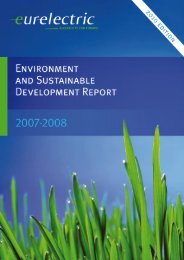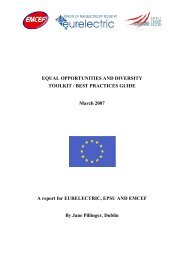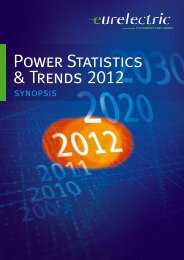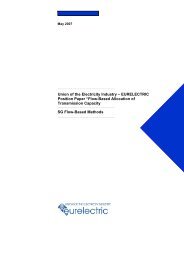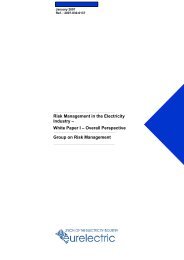Hydro in Europe: Powering Renewables - Full Report - Eurelectric
Hydro in Europe: Powering Renewables - Full Report - Eurelectric
Hydro in Europe: Powering Renewables - Full Report - Eurelectric
Create successful ePaper yourself
Turn your PDF publications into a flip-book with our unique Google optimized e-Paper software.
over 50 valleys along the west coast of Ireland located 1-3 km <strong>in</strong>land from the Atlantic<br />
shore.<br />
Natural <strong>Hydro</strong> Energy Ltd is currently rais<strong>in</strong>g capital for a massive hydro storage project<br />
formed from a rock fill dam across the mouth of one of these natural valleys. It is<br />
hoped this first and subsequent similar projects will make Ireland a significant player <strong>in</strong><br />
<strong>Europe</strong>an energy markets. The cost of the first 1,5GW station with networks to collect<br />
w<strong>in</strong>d energy and transmit bulk hydro and comb<strong>in</strong>ed w<strong>in</strong>d power to the east coast for<br />
connection to the National Grid and <strong>in</strong>terconnectors for export to the UK and <strong>Europe</strong> is<br />
some €2 Bn.<br />
The plan envisages construction of large, <strong>in</strong>dustrial scale w<strong>in</strong>d farms of around 100<br />
MW, by <strong>in</strong>dependent operators. This size will ensure economy of scale. They will be<br />
connected to the <strong>Hydro</strong> Storage Reservoir by 220kV collection networks. Energy will be<br />
stored <strong>in</strong> the reservoir, primarily at night. The reservoir capacity of over 10 days full<br />
load generation will be released as hydro generation dur<strong>in</strong>g the day and comb<strong>in</strong>ed<br />
with <strong>in</strong>com<strong>in</strong>g w<strong>in</strong>d energy to elim<strong>in</strong>ate fluctuations <strong>in</strong> w<strong>in</strong>d output and provide a<br />
steady flow of controllable / dispatchable power. This will elim<strong>in</strong>ate both w<strong>in</strong>d<br />
<strong>in</strong>termittency and the need for curtailment.<br />
3.5 <strong>Hydro</strong>power – highly efficient, affordable and climate friendly<br />
Optimiz<strong>in</strong>g the use of available resources is certa<strong>in</strong>ly one way that leads to a more<br />
susta<strong>in</strong>able future. Therefore, it is also important to take energy efficiency<br />
considerations <strong>in</strong>to account <strong>in</strong> the energy supply doma<strong>in</strong>, where efficiency is<br />
essentially based on two factors:<br />
• energy conversion rate, and<br />
• energy payback ratio.<br />
Energy conversion rate refers to the number of manipulations required until a primary<br />
natural resource, such as coal, is transformed <strong>in</strong>to electricity. For example,<br />
hydropower and w<strong>in</strong>d power convert natural flows of energy <strong>in</strong> the form of w<strong>in</strong>d or<br />
water <strong>in</strong>to the useful form of electricity. Both have very short and efficient energy<br />
cha<strong>in</strong>s, compared to fossil fuels, which require multiple process<strong>in</strong>g steps.<br />
<strong>Hydro</strong>power plants provide the most efficient energy conversion process. Modern<br />
plants can convert more than 95% of mov<strong>in</strong>g water's energy <strong>in</strong>to electricity, while even<br />
the best fossil fuel plants are only about 60% efficient.<br />
3.5.1 <strong>Hydro</strong>power is the most efficient of all renewable energy sources<br />
Typically, hydropower efficiency rates are rang<strong>in</strong>g between 85% to 95%, what is<br />
significantly higher when compared to about 55% for comb<strong>in</strong>ed-cycle gas turb<strong>in</strong>es, 30<br />
% to 40% for coal or oil fired plants, 30% for w<strong>in</strong>d power and 7% to 17% for solar<br />
photovoltaic panels (IEA. 2000. p.11). Achiev<strong>in</strong>g high efficiencies is possible thanks to<br />
the simplicity of the electricity generation process <strong>in</strong> a hydropower plant: there is no<br />
combustion <strong>in</strong>volved; only direct conversion of mechanical energy <strong>in</strong>to electricity.<br />
41



